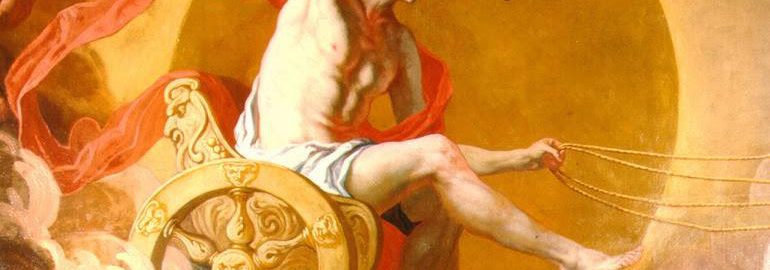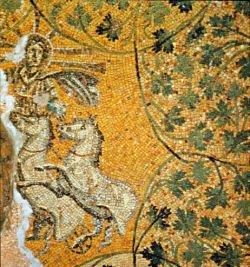What did Christmas look like in Roman times? As it turns out, the association of the Roman festival of Saturnalia with Christmas is inevitable.
An extremely popular and important Roman holiday was Saturnalia, which was a time of universal joy, spending time with family, playing, reconciliation and equality. The poet himself Catullus called them “the best of the days”. Saturnalia was an annual festival honoring the god of agriculture of Saturn, and was celebrated from 17 to 23 December. Originally, Saturnalia only lasted until December 23, but was gradually extended until December 25, when the Sol Invictus was discussed (later).
We learn about the Roman traditions associated with the festival of Saturnalia from the texts of the philosopher Seneca the Younger and the poet Martialis. Both of them mention the celebrators’ mutual giving of presents, their long games and decorating their homes with garlands and lamps. Interestingly, the houses were also adorned with pine branches (in honor of the god who can make plants live even in winter), which was a holy tree on the Apennine Peninsula since the Punic Wars. In the Romans culture, pine symbolized immortality and was an extremely respected plant. We now know that the tradition of decorating Christmas trees comes from the 16th century in Germany; however, it is certain that the conifers were already part of the holidays in Rome.
During the holiday gambling was allowed, huge amounts of wine were drunk, and food was served by the owners (at least during one banquet). During the holidays all business activities were suspended; was free from work and public duties. The time was filled with official ceremonies and home rituals in honor of the gods, lavish banquets, family feasts, and giving out presents.
It is worth mentioning the last 23 day of the holiday – the so-called sigillaria. That day, was given to so-called sigillaria, or traditional gifts: pottery or clay figurines, from which children set scenes depicting the lives of their ancestors. As we know, it is now practiced to build Christmas nativity scenes, which may have reference to Rome. Gifts such as nuts, perfumes, pencil cases, warm clothing and jars with expensive garum (fermented fish sauce) were also popular. Presently, one of the inherent aspects of Christmas is giving gifts. As you can see, this custom was also found in Rome.
The most important Saturnalia rite was that during the holiday the roles of slaves and their masters were changed. At that time, the gentlemen served their slaves one day, serving them dishes at the table or facilitating their daily activities. We didn’t know what it looked like in practice, but we can guess that for many it could have been humiliating, and the slaves were afraid to abuse their masters and not be punished the next day. It seems that the most likely scenario is that the slaves simply ate dinner with their master at one table, and the food was not served, and the owner himself had to bring it to the table. It should be noted that this custom was supposed to resemble the mythical golden age, when Saturn reigned and all people were equal. Moreover, some money was often given to servants and dice were allowed (this was the only time of the year that a slave could gamble). At present, during Christmas, people are also closer, equal and have mutual respect.
An inseparable element of Saturnalia were also family gatherings or large banquets issued by friendly families. Almost everyone organized parties on those days and invited friends to them (according to the Roman saying, it was best to invite guests “more than Charites but less than Muses”, i.e. more than three and less than nine). During the dinner there was a joyful atmosphere full of food and wine (as the basic drink) poured abundantly.
Of course, most of the ancient Romans loved the joyful December holidays, but for some, like Cicero or Seneca not she liked giving slaves freedom for such a short time. They thought these festivities were dangerous, and the chaos that would prevail could enable slave revolt. Cicero accused Catilina of plotting a plot to kill his opponents in Saturnalia.
During Saturnalia, celebrating Romans used to say to each other with the words: Io Saturnalia!, which in our terms can be understood as “Merry Christmas!”.
Finally, it is worth hinting for the day Sol Invictus (Unconquered Sun). Cult of Sol Invictus was a new syncretic cult combining elements of Mithraism, the cult of El Gabal, Baal, Astarte and the Roman solar deity Sol. The Romans worshiped the sun as the embodiment of all other deities. The cult of Sol Invictus was celebrated at the end of the empire, and was introduced by Emperor Aurelian (reigned 270-275 CE). Celebrating Sol Invictus, falling on December 25, for the first time it is certified in 354 CE1 Interestingly, the Catholic Church at the end of the 4th century, he rewrote the celebration of his holiday – Christmas. In addition, early Christians portrayed Christ in a very similar way to Helios or Sol Invictus – namely as a beardless figure, in a wavy coat, driving a chariot with four white horses. It is also highly probable that the date of December 25 was to be a competitive day and in opposition to the pagan feast of the birth of God-Sun, celebrated on the same day, and it was the former Christians who decided to refer to Christ as the “Sun of Justice”. In addition, interestingly, in old churches we can sometimes find inscriptions “Deus Optimus Maximus” (“The greatest and best god”). The Romans worshiped Jupiter just under the nickname Best and Greatest, as “Iuppiter Optimus Maximus”.
In summary, one can clearly see how much Roman culture had an impact on our current customs. Christmas imitates Saturnalia customs in virtually every matter. It should be emphasized that this is a praiseworthy situation, taking into account the fact that this Roman holiday was most beloved by the Romans, and because it accumulated only positive values.











